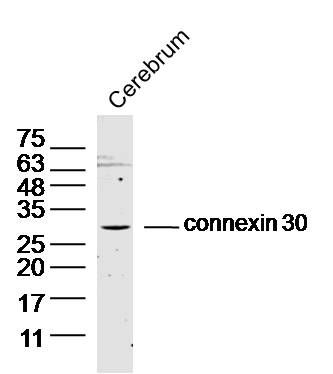产品货号 : mlR23115
英文名称 : connexin 30
中文名称 : 间隙连接蛋白30/GJB6抗体
别 名 : Connexin 30; Connexin-30; Cx30; CXB6_HUMAN; DFNA3; ectodermal dysplasia 2, hidrotic (Clouston syndrome); ED2; EDH; Gap junction beta 6 protein; Gap junction beta-6 protein; gap junction protein, beta 6 (connexin 30); gap junction protein, beta 6; GJB6; HED; NSRD1.
研究领域 : 细胞生物 神经生物学 信号转导 细胞粘附分子
抗体来源 : Rabbit
克隆类型 : Polyclonal
交叉反应 : Human, Mouse, Rat, Cow, Horse, Rabbit, Sheep,
产品应用 : WB=1:500-2000 ELISA=1:500-1000 IHC-P=1:400-800 IHC-F=1:400-800 ICC=1:100-500 IF=1:100-500 (石蜡切片需做抗原修复)
not yet tested in other applications.
optimal dilutions/concentrations should be determined by the end user.
分 子 量 : 29kDa
细胞定位 : 细胞膜
性 状 : Lyophilized or Liquid
浓 度 : 1mg/ml
免 疫 原 : KLH conjugated synthetic peptide derived from human connexin:201-261/261 <Cytoplasmic>
亚 型 : IgG
纯化方法 : affinity purified by Protein A
储 存 液 : 0.01M TBS(pH7.4) with 1% BSA, 0.03% Proclin300 and 50% Glycerol.
保存条件 : Store at -20 °C for one year. Avoid repeated freeze/thaw cycles. The lyophilized antibody is stable at room temperature for at least one month and for greater than a year when kept at -20°C. When reconstituted in sterile pH 7.4 0.01M PBS or diluent of antibody the antibody is stable for at least two weeks at 2-4 °C.
PubMed : PubMed
产品介绍 : The connexin family of proteins form hexameric complexes called connexons that facilitate movement of low molecular weight proteins between cells via gap junctions. Connexin proteins share a common topology of four transmembrane alpha-helical domains, two extracellular loops, a cytoplasmic loop and cytoplasmic N- and C-termini. Many of the key functional differences between connexins arise from specific amino-acid substitutions in the most highly conserved domains: the transmembrane and extracellular regions. Connexin 30, also known as GJB6 (Gap junction beta 6), ED2, EDH, HED or DFNA3, is a 261 amino acid multi-pass membrane protein that localizes to the cell junction and belongs to the connexin family. Functioning as a hexamer with other connexin proteins, connexin 30 facilitates the diffusion of low molecular weight materials from one cell to another. Defects in the gene encoding connexin 30 are the cause of ectodermal dysplasia type 2 (ED2) and non-syndromatic sensorineural deafness autosomal dominant type 3 (DFNA3), the former of which is characterized by abnormal development of ectodermal structures (such as skin and nails).
Function:
One gap junction consists of a cluster of closely packed pairs of transmembrane channels, the connexons, through which materials of low MW diffuse from one cell to a neighboring cell.
Subunit:
A connexon is composed of a hexamer of connexins. Interacts with CNST
Subcellular Location:
Cell membrane; Multi-pass membrane protein. Cell junction, gap junction.
DISEASE:
Defects in GJB6 are the cause of ectodermal dysplasia type 2 (ED2) [MIM:129500]; also known as Clouston syndrome. Ectodermal dysplasia defines a heterogeneous group of disorders due to abnormal development of two or more ectodermal structures. ED2 is an autosomal dominant condition characterized by atrichosis, nail hypoplasia and deformities, hyperpigmentation of the skin, normal teeth, normal sweat and sebaceous gland function. Palmoplantar hyperkeratosis is a frequent features. Hearing impairment has been detected in few cases of ED2.
Defects in GJB6 are the cause of deafness autosomal recessive type 1B (DFNB1B) [MIM:612645]. DFNB1B is a form of sensorineural hearing loss. Sensorineural deafness results from damage to the neural receptors of the inner ear, the nerve pathways to the brain, or the area of the brain that receives sound information.
Defects in GJB6 are the cause of deafness autosomal dominant type 3B (DFNA3B) [MIM:612643].
Similarity:
Belongs to the connexin family. Beta-type (group I) subfamily.
SWISS:
O95452
Gene ID:
10804
Important Note:
This product as supplied is intended for research use only, not for use in human, therapeutic or diagnostic applications.
产品图片












